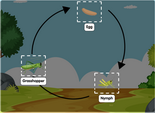Life cycle of a cockroach diagram quiz
Cockroaches are a nuisance for most people especially as they live at home and tend to destroy furniture and books. This page explains the life cycle of a cockroach. A cockroach undergoes three developmental stages throughout its life i.e. egg, nymph, and adult stages.
Female cockroaches can lay large number of eggs (10 to 55) at a time. The majority of cockroaches are oviparous, i.e. the eggs develop outside of the mother instead of inside. To protect eggs and young cockroaches, they create nests and lay eggs in warm, moist and tight spaces conducive to a safe and viable environment.
Once a cockroach hatches the egg, the babies enter the nymph stage in which a cockroach will go through moltings or instars, shedding their exoskeletons to grow and get bigger. At the beginning, baby cockroaches will be white in color before darkening to their normal brown coloration as they molt and mature.
Depending on the species, female cockroaches may not care for their nymphs. Some will abandon their young by hiding away from the nest while others care for their offspring throughout their nymph stage. The nymph stage can last from a few months to almost a year.
The average adult cockroach will be 1-1/2 to 3 in. long with three pairs of legs, two pairs of wings and a long pair of antennae on the front of their head. Most cockroaches are brown.
While many cockroach species have wings, the majority do not fly. However, they will crawl quickly from place to place, traveling up to two to three miles per hour to avoid predators. As adults, females will begin courting and attract males to begin the reproduction process.
This page features and interactive online diagram on the stages in the life cycle of a cockroach.











